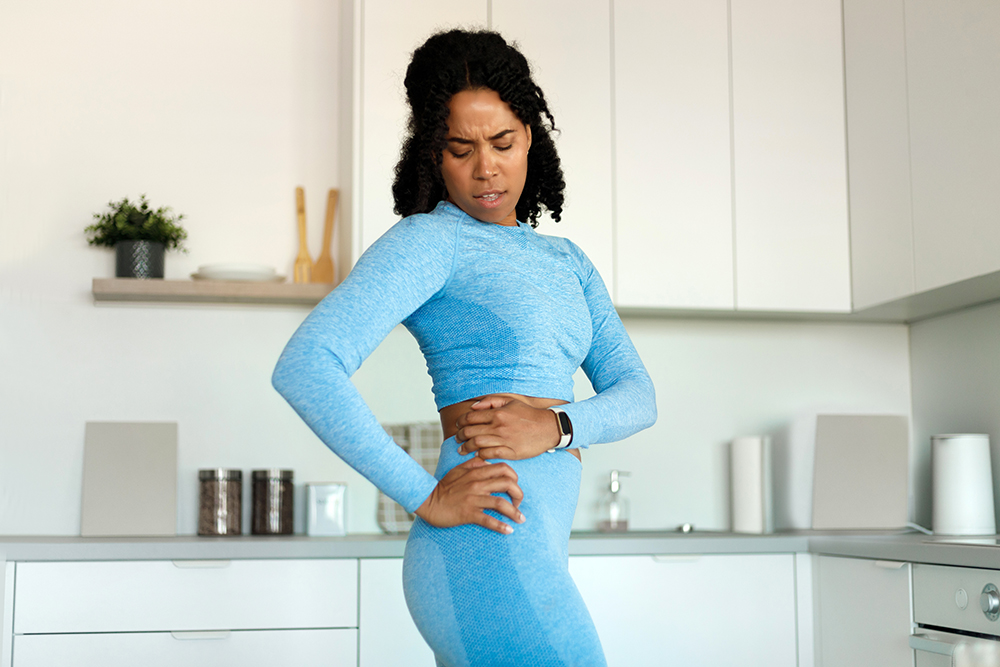Contents
Hip pain while sitting can be a discomforting and disruptive issue that you may be experiencing. Nearly half of adults sit for at least eight hours or more for work. Stiffness and pain don’t have to be a sign that something is wrong; they could just be from holding the same position for extended periods. However, understanding the causes, symptoms, preventive measures and available treatments can be essential in your quest to manage this experience and help alleviate the pain.
What causes hip pain while sitting?
Hip pain while sitting can be due to a variety of issues, including:
- Poor posture — Maintaining poor sitting posture can stress your hip joints. The added pressure can lead to pain over time.
- Muscle imbalances — Weak or tight muscles around your hip can cause pain. This pain can be more likely during extended periods of sitting.
- Osteoarthritis — Osteoarthritis is a degenerative joint disease caused by the degrading of the cartilage in the joints. Sitting for extended periods can lead to pain, stiffness and a reduced range of motion.
- Bursitis — Bursitis is the inflammation of the bursae, which are small fluid-filled sacs that help cushion the bones, tendons and muscles near joints. Bursitis can cause pain, tenderness and swelling after prolonged sitting.
- Tendinitis — Tendinitis is the inflammation of a tendon. Tendinitis can cause pain, stiffness and discomfort.
- Overuse or strain — Doing activities that can overuse the hip muscles or sitting for long periods of time without movement can lead to strain and pain.
- Sciatica — Compression or irritation of the sciatic nerve can cause radiating pain from the lower back down to the hips and legs. Sitting can make it worse.
How does hip pain while sitting feel?
Hip pain while you are sitting can happen in a variety of ways. You may experience:
- Aching discomfort — You may have a dull or sharp pain in the hip area.
- Stiffness — You may have a feeling of tightness or reduced flexibility in the hip joints.
- Radiating pain — Pain may extend to your lower back or down into your legs.
- Numbness or tingling — You may have numbness or tingling in your buttocks or legs.
How should you sit to help prevent hip pain while sitting?
Using some proper sitting habits can help play a crucial role. These habits can help prevent or reduce hip pain while you are sitting
- Maintain good posture — You should sit with your back straight and shoulders relaxed. Keep your feet flat on the floor. This will help distribute your weight evenly.
- Use supportive seating — You will want to choose a chair that offers proper lumbar support. You can use a cushion or pillow to help support the natural curve of your lower back.
- Take breaks and move — It’s important to stand up, stretch and walk around regularly. This is especially important if you have a desk job. Adding in some hip stretches can help keep your muscles flexible.
- Adjust seat height — Make sure your chair is at a height that lets your knees be at your hip level or slightly below.
- Avoid crossing your legs — Crossing your legs can cause hip misalignment. Again, you should sit with your feet flat on the floor.
- Use ergonomic accessories — You may want to use ergonomic accessories like footrests or cushions to help support your posture.
What are treatment options for hip pain while sitting?
Understanding the specific cause of your hip pain while sitting is essential for developing an effective treatment plan. Consulting with a health care professional can help you get a proper diagnosis and personalized approach to managing your hip pain. Treatment options can include:
- Medications — Taking over-the-counter NSAIDs can help with the pain and inflammation. If your pain is severe, your health care provider may prescribe stronger medications.
- Heat and cold therapy — Applying a heating pad or cold pack to the affected area can help ease pain and reduce your inflammation.
- Lifestyle modifications — Weight management is important for many reasons. Being overweight adds additional stress on your hips. You can also avoid sitting for extended periods or activities that make your pain worse.
- Physical therapy — Physical therapy can be an incredibly beneficial treatment choice to help manage hip pain while sitting. A physical therapist can design targeted exercises or stretching routines to help you strengthen your muscles and improve flexibility.
- Injections — If your pain is severe, your health care provider may recommend a corticosteroid for targeted pain relief.
- Surgery — In severe cases, surgery may be considered for conditions that have not responded to conservative treatments.
How can physical therapy help hip pain while sitting?
Hip pain while you are sitting can be a challenging issue. Physical therapy treatments can relieve pain and help improve your overall hip health:
- Aquatic therapy — Aquatic therapy uses the buoyancy of the water to reduce the impact of exercises and stretches on the joints. It can improve flexibility, strength and range of motion in your hip joint.
- Manual therapy — Manual therapy techniques involve hands-on manipulation of soft tissue and joints by a licensed physical therapist. This can include soft tissue manipulation, joint mobilization and stretching. Manual therapy can help reduce muscle tension, improve joint mobility and alleviate pain associated with your hip issues.
- Therapeutic exercises — Therapeutic exercises and stretching can target specific muscles and movements related to hip function. They can help improve stability and flexibility.
- Electrical stimulation — Electrical stimulation involves the application of low-level electrical impulses to specific muscles or nerves. This technique can help reduce pain, decrease muscle spasms and improve muscle strength. It can be used to complement other physical therapy modalities.
Lattimore Physical Therapy can help you overcome the frustrations of hip pain while sitting
At Lattimore Physical Therapy, we understand the frustrations hip pain while sitting can cause you. Our team of expert physical therapists strives to provide compassionate and personalized treatments tailored to your unique needs. We use evidence-based practices to help alleviate your hip pain, and improve your overall mobility and well-being. Choosing Lattimore PT can be a proactive step toward regaining your comfort and functionality as you do your daily activities.
Contact our team today for more information or to schedule an initial appointment.


